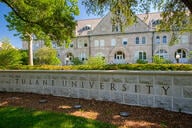You have /5 articles left.
Sign up for a free account or log in.
University of Oregon faculty members may have a union soon, after a group representing faculty members at the university filed about 1,100 signed authorization cards with the state’s Employment Relations Board Tuesday. Officials at United Academics, an organization representing tenure-track, non-tenure-track and research professors, said that the number represented a majority of the institution's approximately 2,000 faculty members.
The university has until April 4 to object to the petition for unionization, according to an official at the Employment Relations Board. Oregon is a state where no election is required as long as a certified majority of the employees in the proposed unit file cards. A challenge could theoretically come if 30 percent of the faculty members petition for an election, but no organizing has taken place for such a challenge.
The now-likely formation of the faculty union at Oregon would be a major victory for academic labor, which has struggled in recent years to organize at research universities. “It shows that faculty members are increasingly frustrated at the increased corporatization of research universities,” said Jack Nightingale, associate director for higher education organizing at the American Federation of Teachers. He said the effort to organize at Oregon was about two years old, with the AFT working with the American Association of University Professors and local faculty members.
Deborah Olson, an instructor at the university’s College of Education, said that faculty members don’t have a voice and have been alienated from the decision-making process. “They are fairly powerless,” said Olson, who is on the Organizing Committee of United Academics.
Another United Academics Organizing Committee member, Gordon Sayre, an English professor, said faculty input is not respected in budgeting or in campus planning. Sayre said that faculty salaries at the university continue to lag behind those at peer institutions. “And when we did get raises last year, it seemed to be a very secretive process,” he said.
According to figures from Howard Bunsis, chair of the American Association of University Professors Collective Bargaining Congress and a professor of accounting at Eastern Michigan University, the number of full-time faculty members at the university increased by 15 percent from the fall of 2005 to the fall of 2010, while the number of administrators increased by 26 percent in the same time period. Student enrollment went up by 15 percent in that time. “The faculty realized that we are better off when we act collectively. I think that’s what this is about,” Bunsis said.
Robert Berdahl, interim president at the university, said in an e-mail that the university was notified Wednesday that the authorization cards have been submitted. “The university has not had an opportunity to review the petition for certification yet and it is premature to comment further,” the e-mail said.
When the union drive started, the university pledged neutrality. A spokesman said at the time that the university's leaders "support the right of workers to organize and have maintained neutrality on the issue of a faculty union. The university seeks to simply provide factual information to assist those affected by the effort to make informed decisions."




